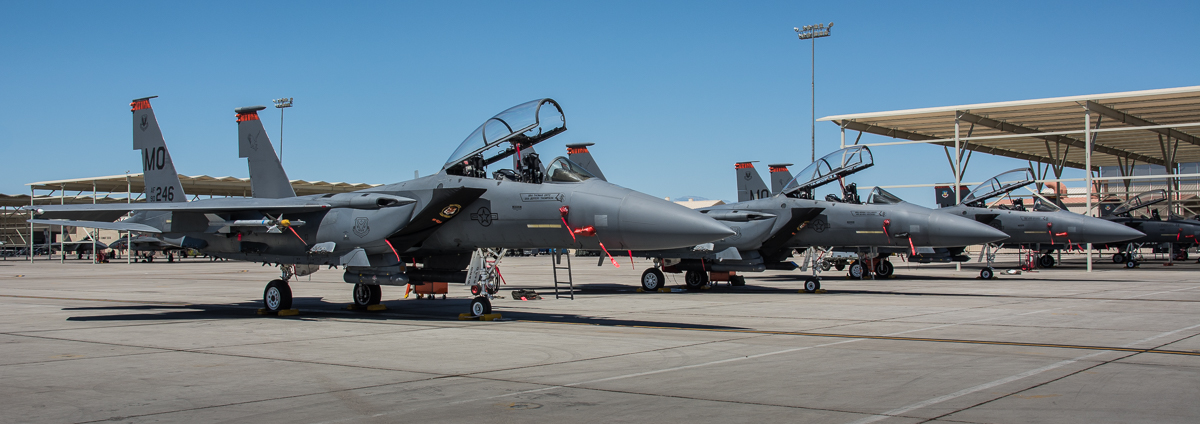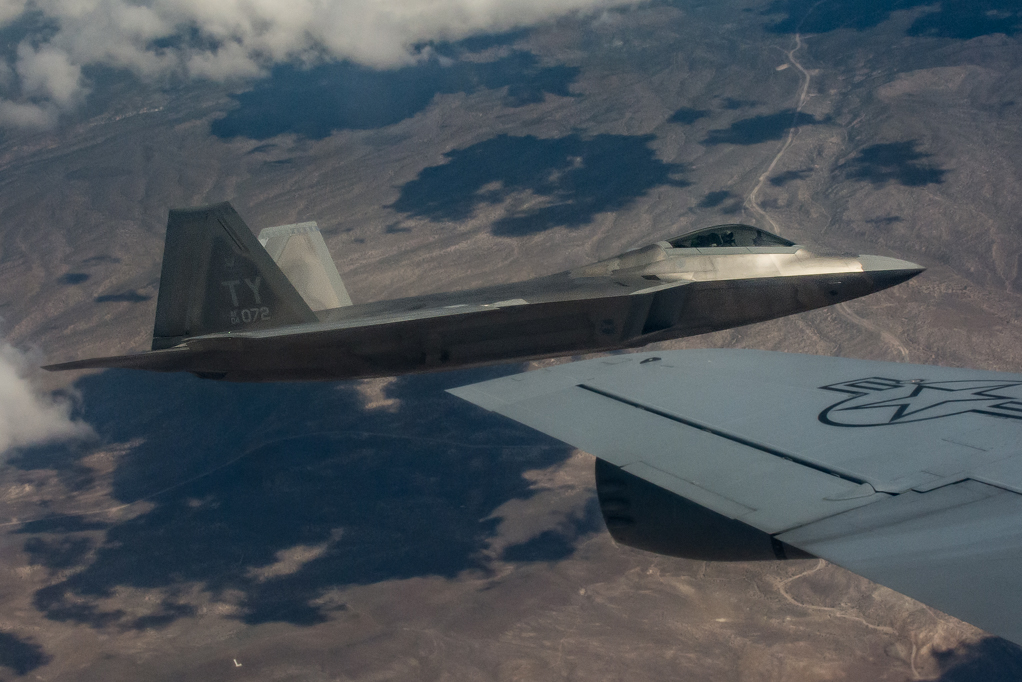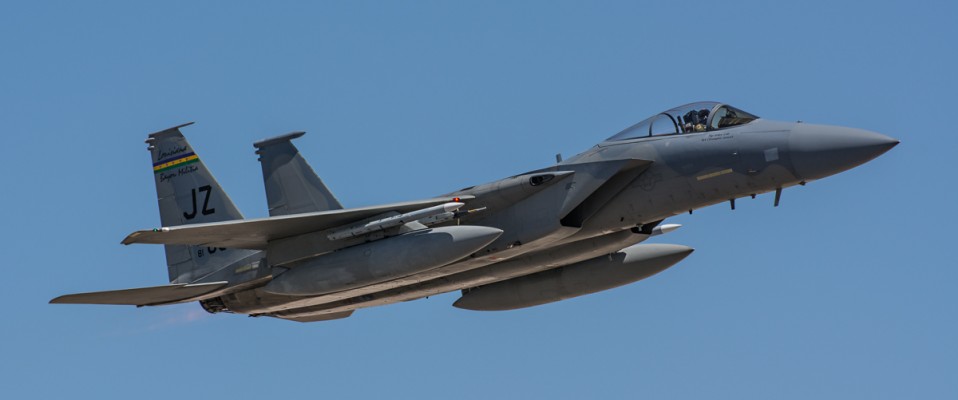Red Flag 15-3: The Eagles Have Landed
Article and Photos by Steven Valinski
August 16, 2015
With 105 degree Fahrenheit (40.5 degree Celsius) plus temperatures, the Las Vegas, Nevada area is not the ideal location to visit in mid-July. The hot midday sun and arid conditions are enough to leave a person longing for a pool of ice water to dive into.
Still, thousands of aviators, crew and support personnel, from around the U.S. and other parts of the world, managed to find themselves at Nellis AFB in Nevada, entrenched in Exercise Red Flag 15-3.
While there appeared to be no underlying theme for Red Flag 15-3, this exercise was unique in that there was no participation from foreign forces. However, this “All-American” Red Flag exercise had representation from each of the major U.S. DoD forces.

An F-15C from the 122nd Fighter Squadron (122nd FS) “Bayou Militia” waiting for its turn to refuel
While Red Flag is designed to simulate a pilot’s first ten combat missions, the way this is accomplished often varies. Red Flag 15-2 saw the incorporation of the “virtual” component along with a continued presence of modern-day threats from cyber and space components.
Major Joe Haggerty of the 414th combat training squadron, and Team Chief for Red Flag 15-3, affirmed this: “Over the evolution of Red Flag, non-kinetics have become a huge part of it. It’s not just the air-to-air and air-to-ground….We do have space and cyber units here playing. They are part of mission planning just like the flyers are, and they bring their abilities to the mission planning day, and they’re and integrated into what the live flyers are doing on the range. They have those discussions to determine what the space and cyber can bring to the fight, to give the effects from the whole battlespace.”
With the 65th Aggressor Squadron standing down after Red Flag 15-1, Red Flag 15-3 saw the continuation of the enhancement of the aggressor or “Red Forces” with participating aircraft. This approach began with Red Flag 15-2 and continued through Red Flag 15-3. Major Haggerty, explains: “We do have augmentation from some participating units. So, besides our local aggressors, we have, actual, ‘Blue’ participants providing some assets to fly ‘Red’ air.” Maj Haggerty went on to explain that several units were being called on to augment the “Red Forces” with aircraft including: US Navy EA-18G Growlers, USMC EA-6B Prowlers, USMC F/A-18A+’s and USAF F-15’s and F-16’s.
Preparation
Preparation and planning is important for success at Red Flag. Some units prepare well in advance for their participation in the exercise. One unit that began preparation as far out as six months ago was the 69th Bomb Squadron out of Minot AFB in North Dakota. Capt. Britt, 69th BS aircraft commander explains: “We started talking about Red Flag about six month ago…I would say our real training program started three months ago, and we rolled through daily sorties. We started simulating what we expected to have here at Red Flag and carried that through so there weren’t any big surprises when we got here.”
This focus on preparation required a block of time that could be allocated for training. “We got back from Guam last year and Red Flag was the next big thing on the docket, so we started focusing on that as early as possible. We wanted to focus on and show the CAF (Combat Air Forces) what we could do so that when we got here our entire unit was on the same sheet of music, could perform as well as we could, and didn’t’ look like the slow ponies when we showed up,” said Britt.
Preparation continues while units are participating in Red Flag with mission planning days. This is where all forces, blue, red and white, unite for a common goal…executing the mission while maintaining a safe training environment for all involved. While knowing some of the other force’s plans may appear counterintuitive to a “realistic combat experience”, the safety of the aviators operating in a confined battlespace is paramount. This commitment to safety begins with mission planning. Capt. Britt explains: “That is all on mission planning day…100%. We all have our contracts that we set up the day before. We say ‘hey, I’m going to be here at this time, you are going to be here at this time’…don’t violate that. If you do violate it, that’s where you get yourself in some sort of flight path where you may become a factor to somebody else. So, doing our jobs like professionals…doing what we say we are going to do, when we say were going to do it. Then, communicating clearly when we deviate from that, for whatever reason. Also, using AWACS support to have eyes in the sky on us all to help us all deconflict. It’s ‘Red Air’ versus ‘Blue Air’ out there, but when it comes to deconfliction, everybody’s on the same team as far as bringing home all the jets safely.”
With this approach to mission planning, success is often determined by how well the plan is executed.

Participants
As with most Red Flag exercises, Red Flag 15-3 included a wide range in the type of assets that were participating.
In the realm of fighter aircraft, in the interdiction role, the USAF relied heavily on Eagles and Strike Eagles. Two units from Mountain Home AFB were present. The 389th Fighter Squadron (389 FS) “Thunderbolts” and the 391st Fighter Squadron (391 FS) “Bold Tigers”, both fly the McDonnell Douglas F-15E Strike Eagle. Both units were away from home while the runway and taxiways are being upgraded at Mountain Home AFB. Originally built in 1943, and “touched up” throughout the years, Mountain Home AFB’s runway was considered in poor shape and a threat for FOD and other safety concerns.
Flying the McDonnell Douglas F-15C Eagle, the 122nd Fighter Squadron (122nd FS) “Bayou Militia” of the Louisiana Air National Guard’s 159th Fighter Wing also participated.

A Lockheed Martin F-22A Raptor from the 95th Fighter Squadron (95 FS) “Boneheads” waits to refuel from a KC-135
The USAF was not without the presence of the F-16 Fighting Falcon. The 480th Fighter Squadron (480 FS) “Warhawks” from Spangdahlem Air Base, Germany made the journey overseas to participate. Some of the 480th FS’s F-16CM’s were painted with “Have Glass” coating. Have Glass is a Radar-absorbent material (RAM) coating similar to what is used on 5th generation aircraft. The coating gave the aircraft a gunmetal-like surface appearance.
Other F-16’s, which operated in a SEAD (Suppression of Enemy Air Defenses) role, were the F-16CM’s from the 55th Fighter Squadron (55 FS) out of Shaw AFB in South Carolina. Various squadrons of F-16’s from Shaw AFB have a regular presence at Red Flag.
Other assets that operated in a SEAD role included: Boeing EA-18G Growlers from Electronic Attack Squadron 138 (VAQ-138) “Yellow Jackets” out of Naval Air Station Whidbey Island, Washington and Northrop Grumman EA-6B Prowlers from Marine Tactical Electronic Warfare Squadron 4 (VMAQ-4) “Seahawks” out of Marine Corps Air Station Cherry Point, North Carolina.
As aggressors, Nellis AFB’s own 64th Aggressor Squadron participated with their F-16’s.
The USMC also participated with McDonnell Douglas F/A-18A+ Hornets from Marine Fighter Attack Squadron 115 (VMFA-115) “Silver Eagles” out of Marine Corps Air Station Beaufort, South Carolina.
5th generation aircraft participation was from the Lockheed Martin F-22A Raptor’s of the 95th Fighter Squadron (95 FS) “Boneheads” out of Tyndall Air Force Base, Florida.
For bomber assets, as mentioned earlier, the 69th Bomb Squadron (69 BS) “Knighthawks” with four Boeing B-52H Stratofortress’ supported Red Flag 15-3. In addition, the exercise was supported by the Northrop Grumman B-2 Spirit flying out of Whiteman Air Force Base, Missouri. In a USAF interview, Major William Lutmer, 414th Combat Training Squadron director of operations stated: “We were able to have B-2 (Spirits) support the exercise from Whiteman Air Force Base which provided additional assets for integration above what we had on the ramp at Nellis AFB.”
Special purpose aircraft included: Boeing E-3A Sentry’s from 960th Airborne Air Control Squadron (960 AACS) from Tinker AFB, Oklahoma, Boeing RC-135V/W Rivet Joint’s from the 38th Reconnaissance Squadron (38 RS) from Offutt AFB, Nebraska, Northrop Grumman E-8 Joint STARS (JSTARS) from the 16th Airborne Command and Control Squadron (16 ACCS) out of Robins AFB, Georgia, Boeing KC-135 Stratotankers from 344th Air Refueling Squadron (344 ARS) out of McConnell AFB, Kansas and Lockheed EC-130H Compass Call aircraft from 43rd Electronic Combat Squadron (43 ECS), Davis-Monthan AFB, Arizona.
A complete list of Red Flag 15-3 participants can be found HERE

CSAR
The Combat Search and Rescue (CSAR) component of Red Flag has become more of an emphasis. For Red Flag 15-3, US Navy and USAF personnel recovery teams took part with support from the F-16’s of the 422nd Test and Evaluation Squadron. According to Maj Lutmer: “We have had F-16 (Fighting Falcons) from the 422nd Test and Evaluation Squadron acting as dedicated SANDY pilots throughout the exercise. It is the first time in over two years that we have had qualified SANDY pilots and it has made a big difference in the level of personnel recovery training we have been able to accomplish. They have been working with Air Force HH-60G (Pave Hawks) and Navy MH-60s supporting as recovery vehicles.”
A SANDY is a pilot specially trained in search procedures, survivor location and authentication techniques. SANDY pilots are also skilled in supporting rotorcraft for CSAR missions.
With the 414th Combat Training Squadron taking over the facilitation and coordination of Angel Thunder, the world’s largest personnel recovery exercise, one can expect the CSAR component of Red Flag to increase in significance. Lessons learned from both exercises can be exchanged to help train personnel recovery forces from the U.S. and partner nations in the best personnel recovery practices.
Importance
The importance of large-scale exercises cannot be understated. DoD and coalition forces with dissimilar assets, procedures and terminology need to learn how to work together, under duress, to keep and maintain combat readiness.
Maj Lutmer had this to say: “One of the key benefits of Red Flag is getting to plan with a diverse set of units all in the same building. While the team will be very similar in combat, all the planners will not be in the same place. The lessons that are learned at Red Flag will need to be applied in combat when geographic separation will make communication and coordination more difficult. Additionally, air power is a product of multi-service, multi-(mission design series), and multi-domain integrated warfighting. Red Flag 15-3 was able to bring together U.S. Air Force, Navy and Marine Corps assets from the air, space, and cyberspace domains.”
At the unit and individual level, Red Flag raises the level of performance of both. “I would say at the unit level there is no better training than this in the world,” Capt. Britt said. “It’s definitely one of those things where there are people that have been to Red Flag and there’s people that haven’t and your level of training, your level of expertise and skill increases significantly while you’re here. Having all these assets and all the opportunities here at the same time, you simply can’t beat it. It’s the biggest bang for your buck.”
In the hot summer Nevada sun, Red Flag 15-3 was a success. With 3000+ personnel and almost 100 aircraft participating, Red Flag continued its large-scale presence in the Nevada skies.
With participation from Israel, Jordan, Singapore and various DoD units, Red Flag 15-4 appears to be a grand finale for the 2015 iterations of Red Flag. With the value and results the exercise delivers, one can hope that the FY-16 budget allows for four Red Flag exercises next year.
Red Flag 15-3 took place July 13-31, 2015 and was hosted by Nellis AFB in Nevada.
Aviation Photography Digest would like to thank: MSgt Sanjay Allen, SSgt Darlene Seltmann, SrA Thomas Spangler, SrA Joshua Kleinholz, A1C Jake Carter and the remainder of the 99 ABW/PA for their support.
Steven is from Long Island, New York and now resides in sunny Mesa, Arizona. Steven’s love for aviation began when he was a child with a fascination for WWII aircraft. This love of aviation was further fostered by his uncle, a long-time Trans World Airlines (TWA) employee who had a passion for all forms of aviation.
Steven’s interest in photography began when he was 16 years old when he received his first SLR camera, a Minolta XGA. It makes sense that eventually his passion for aviation and photography would merge into a love for aviation photography.
In addition to being the web designer, webmaster and chief editor of Aviation Photography Digest, Steven has been published in numerous magazines worldwide.
Steven has an M.S. from Boston University and uses Nikon photographic equipment.
Steven is a Nikon NPS member.
Steven can be reached at: [email protected]


